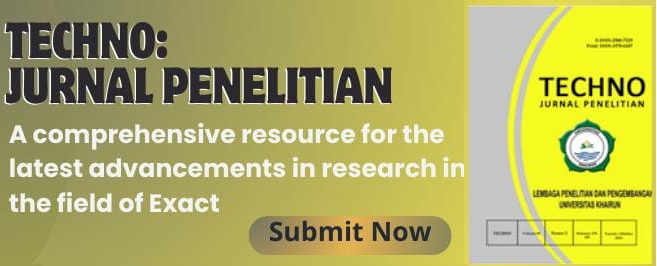Livelihood Asset Maps: Livelihood Assets Concerning The Echo-Agro-Tourism Community-Based Management of The Komunitas Cengkih Afo in Tongole Ternate-North Maluku
Abstract
Humans need livelihood assets for their survival which particularly are related to the resources that are available in their environment and/or can be accessed to meet their needs. Livelihoods assets which are including capabilities, assets, and activities that carry out to support the fulfillment of basic life needs. The Department for International Development (DFID) identifies 5 categories of assets used for livelihoods which consist of human, natural, financial, physical, and social capitals. The majority of people who live in Tongole Village work as farmers, and therefore by the presence of the echo-agro tourism activities, the livelihood assets of the community can increase and/or vary because there are other possible options to increase the economic income earned. The research is aiming to identify the use of livelihood assets by the farmer groups in Komunitas Cengkih Afo. The study has taken place in Tongole village, where the Komunitas Cengkih afo is located. Collecting data is using a purposive sampling method, which refers only to the member of the Komunitas Cengkih Afo. Data on livelihood assets is taken base on the criteria set out according to the pentagon diagram which consists of human, natural, financial, physical, and social capitals. Livelihood assets are categorized in high, medium, and low categories from each respondent. The influence of livelihood assets was analyzed using a scoring method and presented in a pentagon diagram for each capital. Results showed that human, natural, and social capital were the most utilized for all the members, while physical and financial capital was less utilized and/or at the moderate level.
Keywords
Full Text:
PDFReferences
Aazami, M., & Shanazi, K. (2020). Tourism wetlands and rural sustainable livelihood: The case from Iran. Journal of Outdoor Recreation and Tourism, 30(March), 100284. https://doi.org/10.1016/j.jort.2020.100284
Alobo Loison, S. (2015). Rural Livelihood Diversification in Sub-Saharan Africa: A Literature Review. Journal of Development Studies, 51(9), 1125–1138. https://doi.org/10.1080/00220388.2015.1046445
Apine, E., Turner, L. M., Rodwell, L. D., & Bhatta, R. (2019). The application of the sustainable livelihood approach to small scale-fisheries: The case of mud crab Scylla Serrata in Southwest India. Ocean and Coastal Management, 170(December 2018), 17–28. https://doi.org/10.1016/j.ocecoaman.2018.12.024
Berchoux, T., & Hutton, C. W. (2019). Spatial associations between household and community livelihood capitals in rural territories: An example from the Mahanadi Delta, India. Applied Geography, 103(July 2018), 98–111. https://doi.org/10.1016/j.apgeog.2019.01.002
DFID. (1999). Sustainable Livelihoods Guidance Sheets, section 2.1. Department for International Development (DFID). Department for International Development, 26. http://www.livelihoodscentre.org/documents/20720/100145/Sustainable+livelihoods+guidance+sheets/8f35b59f-8207-43fc-8b99-df75d3000e86
Ellis, F. (2000). Rural Livelihoods and Diversity in Developing Countries. Oxford University Press.
FAO. (2018). FAO framework on rural extreme poverty.
Gai, A. M., Poerwati, T., Maghfirah, F., & Sir, M. M. (2020). Analysis of Sustainable Livelihood level and its Influence on Community Vulnerability of Surumana Village, Central Sulawesi. Journal of Regional and Rural Development Planning, 4(3), 209–220. https://doi.org/10.29244/jp2wd.2020.4.3.209-220
Jacobsen, K. (2012). Livelihood asset maps: A multidimensional approach to measuring risk-management capacity and adaptation policy targeting-a case study in Bhutan. Regional Environmental Change 13(2). https://doi.org/DOI http://dx.doi.org/10.1007/s10113-012-0320-7
Jele. Z. (2012). The Contribution of Small-Scale Timber Farming in Enhancing Sustainable Livelihood at Sokhulu. The University of South Africa. South Africa.
Kementrian Pariwisata. (2018). Rencana Strategis. Kementrian Pariwisata 2018-2019.
Li, H., Nijkamp, P., Xie, X., & Liu, J. (2020). A new livelihood sustainability index for rural revitalization assessment-a modeling study on smart tourism specialization in China. Sustainability (Switzerland), 12(8). https://doi.org/10.3390/SU12083148
Oktalina, S. N., Awang, S. A., Hartono, S., Vokasi, S., Mada, U. G., Yogyakarta, S., Yogyakarta, B., Kehutanan, F., Mada, U. G., Yogyakarta, B., Pertanian, F., Mada, U. G., & Yogyakarta, B. (2016). The Farmer Livelihood Asset Mapping on Community Forest Management in Gunungkidul District. Jurnal Manusia Dan Lingkungan, 23(1), 58–65.
Pandey, R., Jha, S. K., Alatalo, J. M., Archie, K. M., & Gupta, A. K. (2017). Sustainable livelihood framework-based indicators for assessing climate change vulnerability and adaptation for Himalayan communities. Ecological Indicators, 79, 338–346. https://doi.org/10.1016/j.ecolind.2017.03.047
Singgalen, Y. A., Sasongko, G., & Wiloso, P. G. (2019). Ritual capital for rural livelihood and sustainable tourism development in Indonesia. Jurnal Manajemen Hutan Tropika, 25(2), 115–125. https://doi.org/10.7226/jtfm.25.2.115
Su, M. M., Wall, G., Wang, Y., & Jin, M. (2019). Livelihood sustainability in a rural tourism destination - Hetu Town, Anhui Province, China. Tourism Management, 71(October 2018), 272–281. https://doi.org/10.1016/j.tourman.2018.10.019
Sugiyono. (2013). Metode penelitian Kuantitatif Kualitatif dan R & D. Alfabeta.
UNDP. (2017). GUIDANCE NOTE: Application of the Sustainable Livelihoods Framework in Development Projects.
Wijayanti, R., Baiquni, M., & Harini, R. (2016). Strategi Penghidupan Berkelanjutan Masyarakat Berbasis Aset di Sub DAS Pusur, DAS Bengawan Solo. Jurnal Wilayah Dan Lingkungan, 4(2), 133. https://doi.org/10.14710/jwl.4.2.133-152
Wijayanto, H., Affandi, A., & Soemarno, S. (2019). Pengaruh Livelihood Asset terhadap Livelihood Strategies Masyarakat Tepi Hutan di UB Forest Desa Tawangargo Kecamatan Karangploso Kabupaten Malang. Habitat, 30(2), 54–61. https://doi.org/10.21776/ub.habitat.2019.030.2.7
DOI: https://doi.org/10.33387/tjp.v10i1.3074
Refbacks
- There are currently no refbacks.
Copyright (c) 2021 Mardiyani - Sidayat

This work is licensed under a Creative Commons Attribution-NonCommercial 4.0 International License.
-------------------------------------------------------------------------------------------------------------------------------------------------------------------
-------------------------------------------------------------------------------------------------------------------------------------------------------------------
TECHNO: Jurnal Penelitian
Published by: LPPM Universitas Khairun
Addres : Jalan Yusuf Abdurrahman Kampus II Unkhair, Kelurahan Gambesi, 97722 Kecamatan Kota Ternate Selatan, Provinsi Maluku Utara, Email: techno@unkhair.ac.id | URL: http://ejournal.unkhair.ac.id/index.php/Techno
Techno Jurnal Penelitian is licensed under a Creative Commons Attribution-NonCommercial 4.0 International License.


























